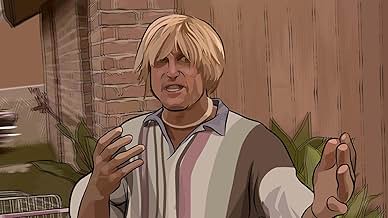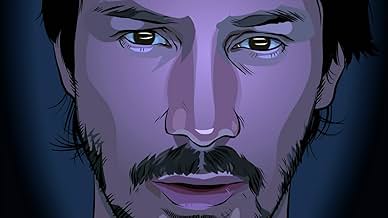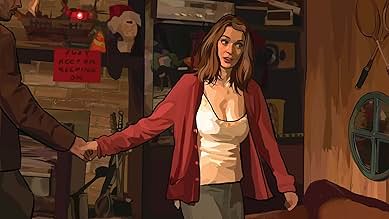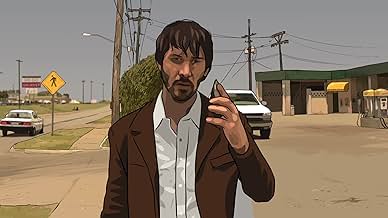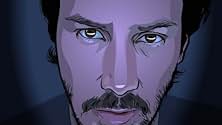En un futuro no muy lejano, un policía encubierto comienza a perder su propia identidad a consecuencia de una peligrosa nueva droga.En un futuro no muy lejano, un policía encubierto comienza a perder su propia identidad a consecuencia de una peligrosa nueva droga.En un futuro no muy lejano, un policía encubierto comienza a perder su propia identidad a consecuencia de una peligrosa nueva droga.
- Dirección
- Guionistas
- Elenco
- Premios
- 4 premios ganados y 21 nominaciones en total
Natasha Janina Valdez
- Waitress
- (as Natasha Valdez)
- Dirección
- Guionistas
- Todo el elenco y el equipo
- Producción, taquilla y más en IMDbPro
Opiniones destacadas
Saw this film today in a theater with no air conditioning on the hottest day of the year...pretty fitting for a movie about claustrophobic paranoia. I'd been looking forward to seeing this from the first time I saw the trailer. Whatever can be said about this film, there is no denying it's totally unique look. After awhile, you begin to get used to the rotoscoping and then suddenly, there will be something thrown in that will call attention to itself and remind you that you are watching animation. I am a fan of Dick's work, but have not yet read the novel upon which this film is based. Great performances all around and kudos to Linklater for his fantastic vision. The film could be considered a bit talky to the average moviegoer, but is much appreciated by fans of cerebral sci-fi. Fascinating premise is told through interesting blend of suspense and comedy. Not for everyone, but certainly worth a look. Certain to become a cult classic.
It's seven years in the future. The country is struggling with 20% of the population addicted to a new drug Substance D. In Anaheim, Bob Arctor (Keanu Reeves) is an undercover agent who wears a scramble suit which changes his appearance like a chameleon. The drug war is supported by private corporation New Path. Bob is himself addicted and starting to lose his mind.
This is an unique movie of an original style. The rotorscoping animation style is hypnotic. It's not for everybody. It can be maddening to watch as the madness of this world can infect the audience. It's a visually weird movie. It gets tiring to watch. It may be better as an animated short than a full-length feature. The talkative story can also wear out its welcome.
This is an unique movie of an original style. The rotorscoping animation style is hypnotic. It's not for everybody. It can be maddening to watch as the madness of this world can infect the audience. It's a visually weird movie. It gets tiring to watch. It may be better as an animated short than a full-length feature. The talkative story can also wear out its welcome.
Like most works by the late Phillip K. Dick, "A Scanner Darkly" provides stinging social commentary embedded in a deeply disturbing vision of a dystopian future. Based on some of his own experiences with drug addiction and rehabilitation, Dick's 1977 novel tells the complex tale of a man who, through an illicit drug he is taking, becomes a split personality, with one half of him being an addict and the other half being a narc - but with neither half aware of the other half's existence. If that sounds like a bit of a "head trip," that is clearly Dick's intent here, for what better way to capture the dreamlike and hallucinatory nature of psychedelic, mind-altering drugs? And what better way for a filmmaker to reproduce that effect on film than through the technique known as "rotoscoping," in which live actors are filmed doing their scenes, then later drawn over and turned into seamlessly flowing animation? This is the style made famous in the 1980's with the A-Ha video "Take on Me" and Linklater's own full length feature in the '90's, "Waking Life." In the case of "A Scanner Darkly," especially, its use results in a perfect marriage of form and content.
In this prescient tale set in the "near future," Keanu Reeves plays the undercover cop, Agent Fred, who, under the pseudonym Bob Arctor, is sent to live in a home with several known drug addicts: Barris, played by Robert Downey Jr. and Luckman, played by Woody Harrelson. When Fred begins taking the newly fabricated drug known as "Substance D," which causes the two hemispheres of the brain to disconnect and go to war with one another, Fred/Arctor becomes essentially two distinctly separate persons, so that, in his capacity as an undercover agent, he is actually spying on himself without realizing it. Winona Ryder appears as Donna, the beautiful but sexually frigid coke addict who becomes Arctor's girlfriend.
"A Scanner Darkly" is an easy film for a viewer to get lost in, so it pays to know a little something about the story before heading into it. As a screenwriter, Linklater captures the woozy insubstantiality of the drug experience well enough but often at the expense of narrative consistency and coherence, especially for the uninitiated. I'm afraid lots of people may become frustrated and confused near the beginning and simply tune out. That would be a real shame because the movie turns into a darkly fascinating rumination on the effect drug use has on the mind, while at the same time raising the ethical issue of just how far the government should go in "sacrificing" innocent victims to achieve a desired, perhaps even laudable, end. At times the movie may seem to be playing both sides of the drug-war fence, yet the sophistication and complexity of Dick's vision keeps it from becoming either an anti-government screed or an anti-drug diatribe.
Some of the dialogue comes off as corny and over earnest, but much of it is incisive and darkly humorous, with Barris and Larkman, in particular, hitting delicious comic heights in their paranoid/delusional ravings and interchanges.
In this prescient tale set in the "near future," Keanu Reeves plays the undercover cop, Agent Fred, who, under the pseudonym Bob Arctor, is sent to live in a home with several known drug addicts: Barris, played by Robert Downey Jr. and Luckman, played by Woody Harrelson. When Fred begins taking the newly fabricated drug known as "Substance D," which causes the two hemispheres of the brain to disconnect and go to war with one another, Fred/Arctor becomes essentially two distinctly separate persons, so that, in his capacity as an undercover agent, he is actually spying on himself without realizing it. Winona Ryder appears as Donna, the beautiful but sexually frigid coke addict who becomes Arctor's girlfriend.
"A Scanner Darkly" is an easy film for a viewer to get lost in, so it pays to know a little something about the story before heading into it. As a screenwriter, Linklater captures the woozy insubstantiality of the drug experience well enough but often at the expense of narrative consistency and coherence, especially for the uninitiated. I'm afraid lots of people may become frustrated and confused near the beginning and simply tune out. That would be a real shame because the movie turns into a darkly fascinating rumination on the effect drug use has on the mind, while at the same time raising the ethical issue of just how far the government should go in "sacrificing" innocent victims to achieve a desired, perhaps even laudable, end. At times the movie may seem to be playing both sides of the drug-war fence, yet the sophistication and complexity of Dick's vision keeps it from becoming either an anti-government screed or an anti-drug diatribe.
Some of the dialogue comes off as corny and over earnest, but much of it is incisive and darkly humorous, with Barris and Larkman, in particular, hitting delicious comic heights in their paranoid/delusional ravings and interchanges.
The film did not set me on fire,but it did try to be faithful to the novel. If it inspires the viewer to read the book or the work/s of P.K.Dick then it has done its job. The animation format used had no influence on my viewing pleasure,it was neither good nor bad,it did not distract me from the theme of the movie. Keanu Reeves I thought was decent in the role of Bob,whether this is due to the colouring effect or not is debatable. Seriously though,Mr Reeves has a limited appeal as an actor to me,but I actually thought he did a good job. I read the book 20 some years ago and enjoyed it immensely,as always the film can never convey the entire book,but I was finally pleased it made it to film in a semi faithful way.
In the near future a powerful new drug substance D is hooking users with every new hit. Losing the battle against the drug, the LAPD place an officer undercover as a substance D user. While the officer's identity is kept secret from his colleagues and superiors, he himself starts to lose touch with who he actually is meant to be. Becoming hooked on the drug himself and becoming friends with the people he is meant to be informing on, the officer starts to suffer a breakdown with memory and concentration loses combined with a loosening grip on reality.
I had reasonably high hopes for this film but also the fear I have when anyone takes on material that some have called "unfilmable". Written at a time when his marriage had broken down and he himself was struggling with his drug use and split identities, Dick's material does offer much of interest as long as it can be delivered in such a way to be engaging and interesting. "Making sense" was not one of the qualities I really needed, which was just as well since narratively there isn't a lot to follow along with. Parts of it are funny, parts of it are trippy and parts of it are dramatic. However none of them really come together to produce anything of that much value. It is a shame that the ideas over identity, drugs and the morals of the war on drugs are not better played out. As it is I didn't think there was enough of interest and, with the narrative being so basic, what remained was surprisingly dull.
The use of the rotoscoping was a smart move and also serves as an interesting hook for multiplex audience (and I include myself therein, so it is not a snobbish reference) that have perhaps not seen it before. Linklater produces some good effects this way and it is hard to think of another approach working as well within the context of the material as it does. Sadly this is not enough to carry the film along, although it will be enough to satisfy some sections of the audience. The cast do the best they can within this unsuccessful mix and most of them are individually good here and there. Reeves is a natural stoner but he doesn't convince with his breakdown and confusion that well; he isn't helped by the lack of focus in the script but he can't lift it regardless. Downey Jr is very funny and convincing and wards off the boredom when he is near. Harrelson tries to follow suit but with a dumber character he just falls flat. Cochrane is more enjoyable and the animation really aids his performance. Ryder is OK but she has too much of the narrative to carry and she cannot do it.
Overall this is an OK film at best. It is sporadically interesting, funny and engaging however it cannot find any consistency of tone, pace or engagement. The material is good enough to throw up interesting ideas and themes but Linklater sadly doesn't manage to do much with them across the film. The use of animation over the film cells is really well crafted and works well to support the material it is just a shame then that the awareness and control that Linklater in this area he seems to lack in others.
I had reasonably high hopes for this film but also the fear I have when anyone takes on material that some have called "unfilmable". Written at a time when his marriage had broken down and he himself was struggling with his drug use and split identities, Dick's material does offer much of interest as long as it can be delivered in such a way to be engaging and interesting. "Making sense" was not one of the qualities I really needed, which was just as well since narratively there isn't a lot to follow along with. Parts of it are funny, parts of it are trippy and parts of it are dramatic. However none of them really come together to produce anything of that much value. It is a shame that the ideas over identity, drugs and the morals of the war on drugs are not better played out. As it is I didn't think there was enough of interest and, with the narrative being so basic, what remained was surprisingly dull.
The use of the rotoscoping was a smart move and also serves as an interesting hook for multiplex audience (and I include myself therein, so it is not a snobbish reference) that have perhaps not seen it before. Linklater produces some good effects this way and it is hard to think of another approach working as well within the context of the material as it does. Sadly this is not enough to carry the film along, although it will be enough to satisfy some sections of the audience. The cast do the best they can within this unsuccessful mix and most of them are individually good here and there. Reeves is a natural stoner but he doesn't convince with his breakdown and confusion that well; he isn't helped by the lack of focus in the script but he can't lift it regardless. Downey Jr is very funny and convincing and wards off the boredom when he is near. Harrelson tries to follow suit but with a dumber character he just falls flat. Cochrane is more enjoyable and the animation really aids his performance. Ryder is OK but she has too much of the narrative to carry and she cannot do it.
Overall this is an OK film at best. It is sporadically interesting, funny and engaging however it cannot find any consistency of tone, pace or engagement. The material is good enough to throw up interesting ideas and themes but Linklater sadly doesn't manage to do much with them across the film. The use of animation over the film cells is really well crafted and works well to support the material it is just a shame then that the awareness and control that Linklater in this area he seems to lack in others.
¿Sabías que…?
- TriviaRobert Downey, Jr. wrote most of his lines down on post-it notes and scattered them around the set so he could read off them while filming a scene. The rotoscoping team simply animated over the notes to remove them from the film during post-production.
- ErroresWhile showing the monitoring equipment, Hank tells Fred that he could be anyone from Arctor's circle of friends, including Barris. This made sense in the book, however, by this time in the movie Hank has already seen Fred alongside Barris, so he could not possibly think they are the same person.
- Citas
Fred: [voiceover] What does a scanner see? Into the head? Down into the heart? Does it see into me? Into us? Clearly or darkly? I hope it sees clearly because I can't any longer see into myself. I see only murk. I hope for everyone's sake the scanners do better, because if the scanner sees only darkly the way I do, then I'm cursed and cursed again.
- Créditos curiososThe "Phil" mentioned in the "in memoriam" list as having permanent pancreatic damage is Philip K. Dick himself.
- Bandas sonorasFog
Written by Thom Yorke (as Thomas Yorke), Phil Selway (as Philip Selway), Jonny Greenwood (as Jonathan Greenwood),
Colin Greenwood and Ed O'Brien (as Edward O'Brien)
Performed by Radiohead
Courtesy of Capitol Records
Under licence from EMI Film & Television Music
Selecciones populares
Inicia sesión para calificar y agrega a la lista de videos para obtener recomendaciones personalizadas
Detalles
- Fecha de lanzamiento
- País de origen
- Sitio oficial
- Idioma
- También se conoce como
- A Scanner Darkly
- Locaciones de filmación
- Productoras
- Ver más créditos de la compañía en IMDbPro
Taquilla
- Presupuesto
- USD 8,700,000 (estimado)
- Total en EE. UU. y Canadá
- USD 5,501,616
- Fin de semana de estreno en EE. UU. y Canadá
- USD 391,672
- 9 jul 2006
- Total a nivel mundial
- USD 7,660,857
- Tiempo de ejecución
- 1h 40min(100 min)
- Color
- Mezcla de sonido
- Relación de aspecto
- 1.85 : 1
Contribuir a esta página
Sugiere una edición o agrega el contenido que falta



